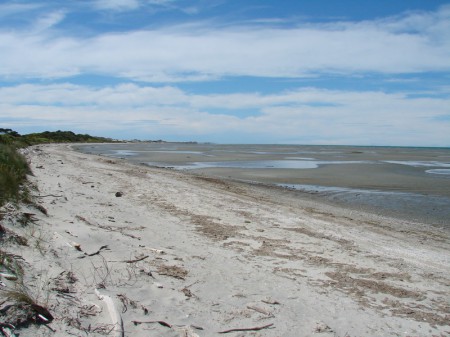Tasman Bay
There are so many things to see and do in the north western corner of the South Island that we could spend months here.
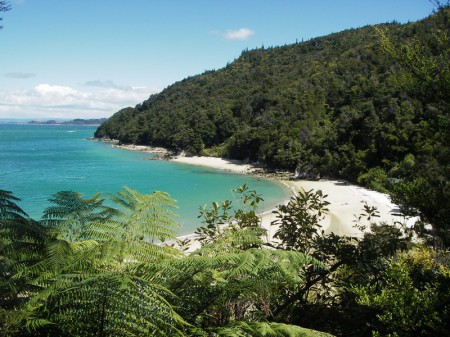 Most of our time was spent doing some of the great walks and fishing the pristine rivers of the area. One of our all-time favorites is the Abel Tasman coastal walk. The scenery changes constantly and secluded golden beaches, bubbling streams and native forest with Nikau palms and tall tree ferns make the Abel Tasman a very unique experience. The entire walk takes several days to complete, with numerous camp sites along the way and the possibility of getting back to the starting point by water taxi. An option we choose when walking the track on a previous trip. We only did a one day walk this time and spent most of our day sunbathing and watching the abundance of different seabirds.
Most of our time was spent doing some of the great walks and fishing the pristine rivers of the area. One of our all-time favorites is the Abel Tasman coastal walk. The scenery changes constantly and secluded golden beaches, bubbling streams and native forest with Nikau palms and tall tree ferns make the Abel Tasman a very unique experience. The entire walk takes several days to complete, with numerous camp sites along the way and the possibility of getting back to the starting point by water taxi. An option we choose when walking the track on a previous trip. We only did a one day walk this time and spent most of our day sunbathing and watching the abundance of different seabirds.
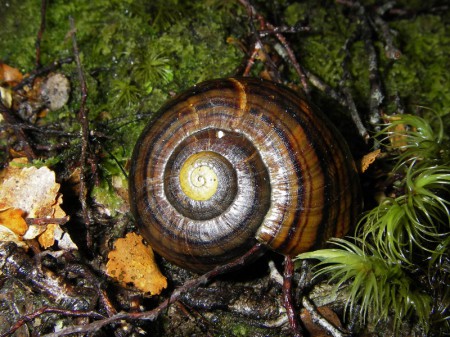 A couple of days later we drove into Canaan on Takaka Hill and to Harwood’s Hole. Harwood’s Hole is a huge sinkhole washed out of limestone rock over millions of years. It’s 50 meters wide and 180 meters deep and abseiling into the dark abyss is an adventure enjoyed by cavers and thrill seekers. Close to the hole is a rocky outcrop with a great view down into the Takaka valley and the mountains beyond. On the way back to the car we came across several Powelliphanta snails, an ancient, carnivore snail species with a beautifully marked shell.
A couple of days later we drove into Canaan on Takaka Hill and to Harwood’s Hole. Harwood’s Hole is a huge sinkhole washed out of limestone rock over millions of years. It’s 50 meters wide and 180 meters deep and abseiling into the dark abyss is an adventure enjoyed by cavers and thrill seekers. Close to the hole is a rocky outcrop with a great view down into the Takaka valley and the mountains beyond. On the way back to the car we came across several Powelliphanta snails, an ancient, carnivore snail species with a beautifully marked shell.
Harwood’s Hole is part of an underground system providing water for the largest spring in Australasia, Waikoropupu Springs, with an average discharge of 14’000 litres a second. A viewing platform with an underwater mirror allows an insight into a magical world, looking like an underwater garden. Water plants in all shades of green and red, native eels, trout and many other creatures share a special eco system with a constant water temperature all year round.
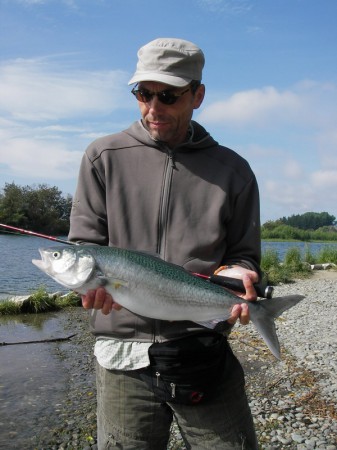 Many of the rivers flowing into the bay attract marine live, especially at high tide and the fishing for Kahawai and other species can be nothing short of outstanding. We picked what turned out to be a good day on one of our last visits to the Motueka river mouth. Flocks of Seagulls were diving into the water and small baitfish were jumping out of the water all around us when we arrived. We got into fish within minutes and the action was red hot for about an hour. Kahawai of up to six pound took our shiny lures with vigor and put up a spirited fight on light spinning gear. Many fish attacked the lure several times before eventually hooking up solid. Our aim to catch them on fly was not successful that day though, with the fish staying in the middle of the river, just out of casting range. Bled properly, Kahawai make very good table fare indeed and we enjoyed a delicious feast of fresh fish that night.
Many of the rivers flowing into the bay attract marine live, especially at high tide and the fishing for Kahawai and other species can be nothing short of outstanding. We picked what turned out to be a good day on one of our last visits to the Motueka river mouth. Flocks of Seagulls were diving into the water and small baitfish were jumping out of the water all around us when we arrived. We got into fish within minutes and the action was red hot for about an hour. Kahawai of up to six pound took our shiny lures with vigor and put up a spirited fight on light spinning gear. Many fish attacked the lure several times before eventually hooking up solid. Our aim to catch them on fly was not successful that day though, with the fish staying in the middle of the river, just out of casting range. Bled properly, Kahawai make very good table fare indeed and we enjoyed a delicious feast of fresh fish that night.
Mount Arthur and the surrounding peaks in the Hinterland of Tasman Bay offer many more hiking opportunities. So one day we drove up to Flora Saddle and walked to Mount Arthur hut. The track from the saddle up to the hut leads through magnificent beech forest. A late spell of snow and heavy wind caused a lot of damage just weeks ago and the forest floor was littered with branches and the odd big tree. With an increase in altitude the plant species changed and more and more Mountain Nainai appeared.
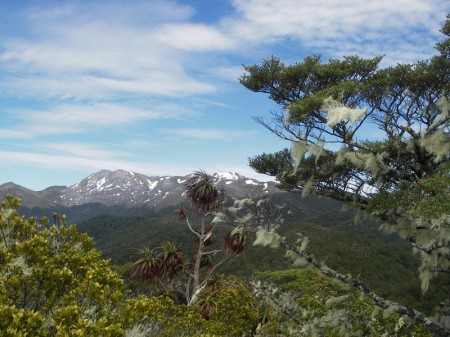 The sound of numerous birds filled the air and inquisitive South Island Robins and a cheeky Weka joined us while we had our lunch at the hut. On the western side of the ridge the vegetation changed again and scrubs rather than tall trees dominated for a while. Further down the track beech forest took over again and we even saw a Morepork or NewZealand owl, an unusual sight in bright daylight. Back at the car park at Flora Saddle, two American tourists arrived in their camper van, looking pretty shattered. The steep and narrow gravel road was obviously too much for them and they turned around after a quick cup of tea without enjoying the breathtaking view.
The sound of numerous birds filled the air and inquisitive South Island Robins and a cheeky Weka joined us while we had our lunch at the hut. On the western side of the ridge the vegetation changed again and scrubs rather than tall trees dominated for a while. Further down the track beech forest took over again and we even saw a Morepork or NewZealand owl, an unusual sight in bright daylight. Back at the car park at Flora Saddle, two American tourists arrived in their camper van, looking pretty shattered. The steep and narrow gravel road was obviously too much for them and they turned around after a quick cup of tea without enjoying the breathtaking view.
We spent another exciting day on a trip to Farewell Spit in Golden Bay. This sand spit, about 1 km wide and extending into the sea for more than 20 km, is of great significance as roosting place for countless seabirds. Black swans can be seen in huge numbers and there is a breeding colony of seals. The spit forms the northern boundary of Golden Bay and its very shallow inner beach proves fatal for stranding whales from time to time. We walked along the sheltered bay side of the spit and crossed the desert like dunes to reach the rougher, exposed outer beach facing the Tasman Sea. The wind was howling and we got sand blasted and backpacks and cameras got filled with fine dark sand all the way back. Walking along a beach and looking out for all the weird and wonderful things the sea has spit out is one of our favorite pastimes. Shells, driftwood of all shapes, pieces of rope, fish skeletons, beautifully marked jellyfish and even a lounge chair were just some of the treasures we came across.
